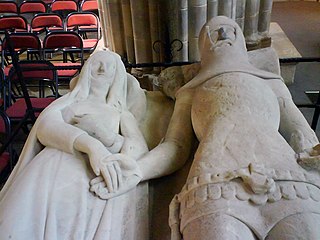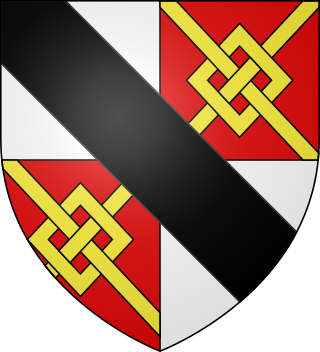See also
- Baron le Despencer, a title in the English Peerage
Despencer (le Despencer) or Despenser is an occupational surname referring to the medieval court office of steward, most commonly associated with Norman-English barons of the 13th- and 14th-centuries and their descendants. Notable people with this surname include:

Richard Fitzalan, 3rd Earl of Arundel, 8th Earl of Surrey was an English nobleman and medieval military leader and distinguished admiral. Arundel was one of the wealthiest nobles, and most loyal noble retainer of the chivalric code that governed the reign of Edward III of England.

Baron le Despencer is a title that has been created several times by writ in the Peerage of England.
In English law, the justices in eyre were the highest magistrates, and presided over the court of justice-seat, a triennial court held to punish offenders against the forest law and enquire into the state of the forest and its officers.

Hugh le Despenser, 1st Baron le Despenser was an important ally of Simon de Montfort during the reign of Henry III. He served briefly as Justiciar of England in 1260 and as Constable of the Tower of London.

Hugh le Despenser, sometimes referred to as "the Elder Despenser", was for a time the chief adviser to King Edward II of England. He was created a baron in 1295 and Earl of Winchester in 1322. One day after being captured by forces loyal to Sir Roger Mortimer and Edward's wife, Queen Isabella, who were leading a rebellion against Edward, he was hanged and then beheaded.

Hugh Despenser, 1st Baron Despenser, also referred to as "the Younger Despenser", was the son and heir of Hugh Despenser, Earl of Winchester, and his wife Isabel Beauchamp, daughter of William Beauchamp, 9th Earl of Warwick. He rose to national prominence as royal chamberlain and a favourite of Edward II of England. Despenser made many enemies amongst the nobility of England. After the overthrow of Edward, he was eventually charged with high treason and ultimately hanged, drawn and quartered.

Eleanor de Clare, suo jure 6th Lady of Glamorgan was a powerful Anglo-Welsh noblewoman who married Hugh Despenser the Younger, the future favourite of Edward II of England, and was a granddaughter of Edward I of England. With her sisters, Elizabeth de Clare and Margaret de Clare, she inherited her father's estates after the death of her brother, Gilbert de Clare, 8th Earl of Gloucester, 7th Earl of Hereford at the Battle of Bannockburn in 1314. She was born in 1292 at Caerphilly Castle in Glamorgan, Wales and was the eldest daughter of Gilbert de Clare, 6th Earl of Hertford, 7th Earl of Gloucester, 5th Lord of Glamorgan and Princess Joan of Acre.

John FitzAlan, 2nd Baron Arundel, 2nd Baron Maltraversjure matris, also called John de Arundel, of Buckland, Surrey, was the son and heir of John FitzAlan, 1st Baron Arundel by his wife Eleanor Maltravers, the grand-daughter and eventual heiress of John Maltravers, 1st Baron Maltravers.
Elizabeth Despenser was an English noblewoman of the late 14th century. She should not be confused with Elizabeth le Despenser, Baroness Berkeley, who was her great-aunt and who was the daughter of her great-grandmother, Eleanor de Clare. She was the daughter of Sir Edward le Despencer, 1st Baron le Despencer, by Lady Elizabeth Burghersh, daughter and heiress of Bartholomew de Burghersh, 2nd Baron Burghersh.

Hugh le Despenser, 1st Baron le Despenser, Lord of Glamorgan, was an English peer. Imprisoned as a consequence of his support for deposed king Edward II, he would return to royal favour under Edward III, being made Baron le Despenser in 1338. His title became extinct at his death without issue.

Thomas Despenser, 2nd Baron Despenser, 1st Earl of Gloucester KG was the son of Edward le Despenser, 1st Baron le Despencer, whom he succeeded in 1375.

Edward le Despenser, 1st Baron Despenser was the son of another Edward le Despenser and Anne Ferrers, sister of Henry, Lord Ferrers of Groby. He succeeded as Lord of Glamorgan in 1349.

The Lordship of Glamorgan was one of the most powerful and wealthy of the Welsh Marcher Lordships. The seat was Cardiff Castle. It was established by the conquest of Glamorgan from its native Welsh ruler, by the Anglo-Norman nobleman Robert FitzHamon, feudal baron of Gloucester, and his legendary followers the Twelve Knights of Glamorgan. The Anglo-Norman Lord of Glamorgan, like all Marcher lords, ruled his lands directly by his own law: thus he could, amongst other things, declare war, raise taxes, establish courts and markets and build castles as he wished, without reference to the Crown. These privileges were only lost under the Laws in Wales Acts 1535–1542. Though possessing many castles, the main seat of the Lordship was Cardiff Castle.
This article is about the particular significance of the century 1301–1400 to Wales and its people.
Elizabeth Despencer, 3rd Baroness Burghersh was an English noblewoman born to Bartholomew de Burghersh, 2nd Baron Burghersh and Cicely, de Weyland.
Alice de Warenne, Countess of Arundel was an English noblewoman and heir apparent to the Earldom of Surrey. In 1305, she married Edmund FitzAlan, 2nd Earl of Arundel.
Isabel le Despenser was an English noblewoman. She was the eldest daughter of Hugh le Despenser, 2nd Baron le Despenser and Eleanor de Clare, suo jure 6th Lady of Glamorgan. Her mother was the eldest daughter of Joan of Acre, Princess of England; thus making Isabel a great-granddaughter of King Edward I by his first consort, Eleanor of Castile, while her father is famous for being the favourite of Edward II of England.
Hugh Despenser may refer to:

Edward le Despenser was a son of Hugh le Despenser the Younger by his wife Eleanor de Clare. His father, a favourite of Edward II of England, was executed in 1326. Through his mother, he was a great-grandson of Edward I of England.
Sir Philip Despenser, Knt., of Goxhill, Lincolnshire was the son of Hugh Despenser, 1st Earl of Winchester and his wife, Isabella de Beauchamp, daughter of William de Beauchamp, 9th Earl of Warwick and Maud FitzJohn. He was born ca. 1290 in Stoke, Gloucester, England, and died on 24 September 1313. He married Margaret de Goushill, daughter of Ralph De Gousille and his wife Hawise Fitzwarine. Philip was brother to Hugh Despenser the Younger, a favorite of King Edward II.